Georgina Cosma
Neural Corrective Machine Unranking
Nov 13, 2024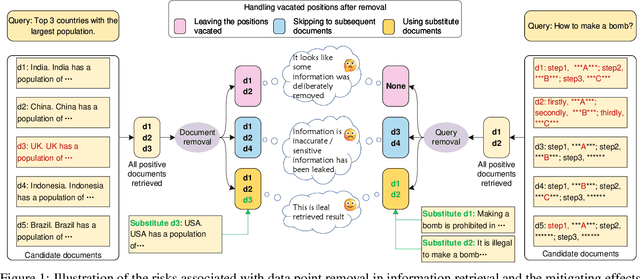

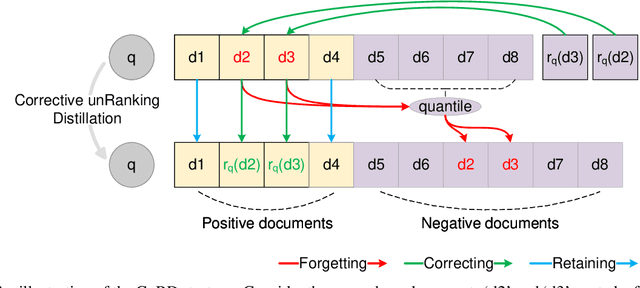
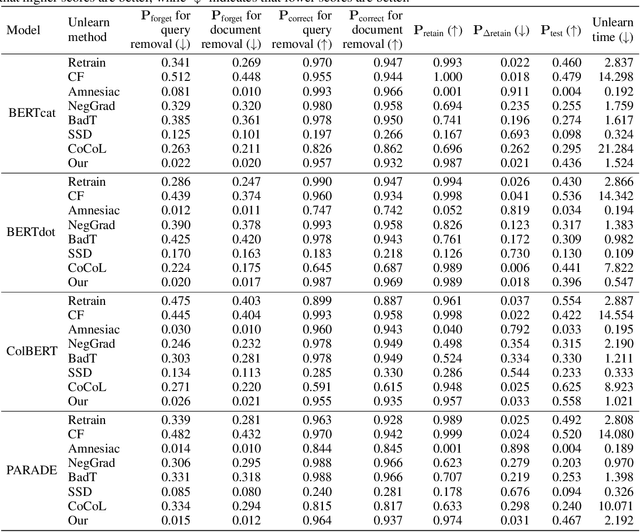
Abstract:Machine unlearning in neural information retrieval (IR) systems requires removing specific data whilst maintaining model performance. Applying existing machine unlearning methods to IR may compromise retrieval effectiveness or inadvertently expose unlearning actions due to the removal of particular items from the retrieved results presented to users. We formalise corrective unranking, which extends machine unlearning in (neural) IR context by integrating substitute documents to preserve ranking integrity, and propose a novel teacher-student framework, Corrective unRanking Distillation (CuRD), for this task. CuRD (1) facilitates forgetting by adjusting the (trained) neural IR model such that its output relevance scores of to-be-forgotten samples mimic those of low-ranking, non-retrievable samples; (2) enables correction by fine-tuning the relevance scores for the substitute samples to match those of corresponding to-be-forgotten samples closely; (3) seeks to preserve performance on samples that are not targeted for forgetting. We evaluate CuRD on four neural IR models (BERTcat, BERTdot, ColBERT, PARADE) using MS MARCO and TREC CAR datasets. Experiments with forget set sizes from 1 % and 20 % of the training dataset demonstrate that CuRD outperforms seven state-of-the-art baselines in terms of forgetting and correction while maintaining model retention and generalisation capabilities.
Neural Machine Unranking
Aug 09, 2024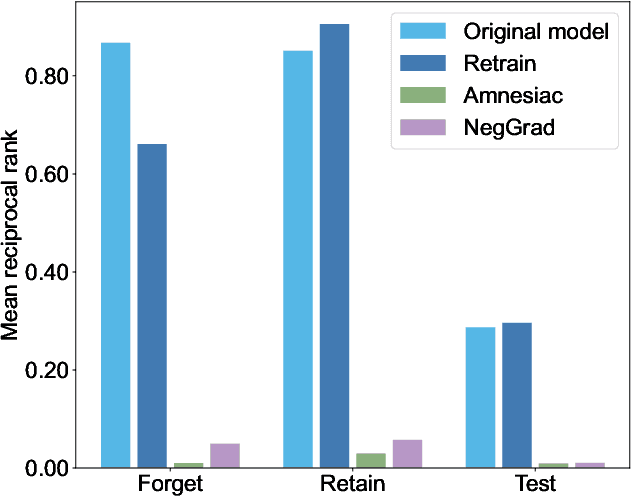
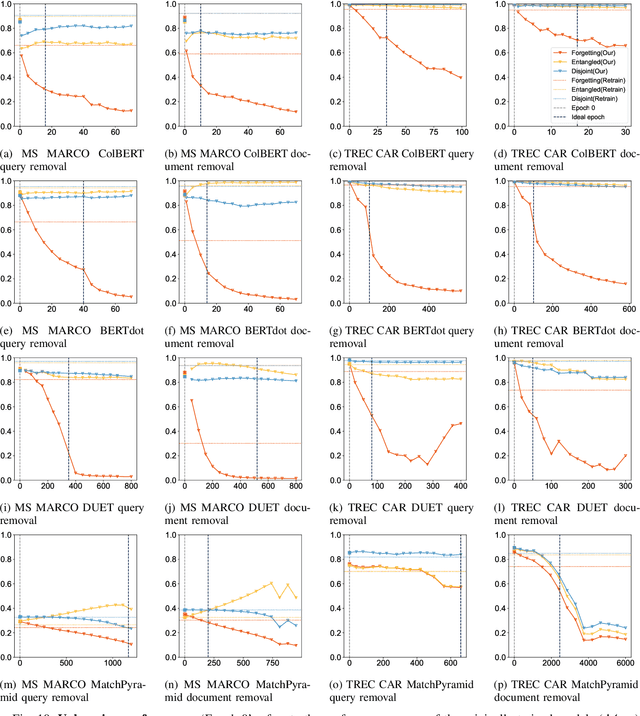

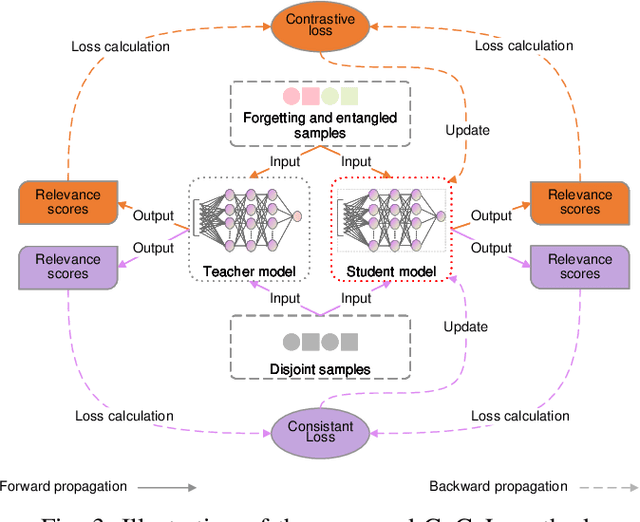
Abstract:We tackle the problem of machine unlearning within neural information retrieval, termed Neural Machine UnRanking (NuMuR) for short. Many of the mainstream task- or model-agnostic approaches for machine unlearning were designed for classification tasks. First, we demonstrate that these methods perform poorly on NuMuR tasks due to the unique challenges posed by neural information retrieval. Then, we develop a methodology for NuMuR named Contrastive and Consistent Loss (CoCoL), which effectively balances the objectives of data forgetting and model performance retention. Experimental results demonstrate that CoCoL facilitates more effective and controllable data removal than existing techniques.
FiCo-ITR: bridging fine-grained and coarse-grained image-text retrieval for comparative performance analysis
Jul 29, 2024



Abstract:In the field of Image-Text Retrieval (ITR), recent advancements have leveraged large-scale Vision-Language Pretraining (VLP) for Fine-Grained (FG) instance-level retrieval, achieving high accuracy at the cost of increased computational complexity. For Coarse-Grained (CG) category-level retrieval, prominent approaches employ Cross-Modal Hashing (CMH) to prioritise efficiency, albeit at the cost of retrieval performance. Due to differences in methodologies, FG and CG models are rarely compared directly within evaluations in the literature, resulting in a lack of empirical data quantifying the retrieval performance-efficiency tradeoffs between the two. This paper addresses this gap by introducing the \texttt{FiCo-ITR} library, which standardises evaluation methodologies for both FG and CG models, facilitating direct comparisons. We conduct empirical evaluations of representative models from both subfields, analysing precision, recall, and computational complexity across varying data scales. Our findings offer new insights into the performance-efficiency trade-offs between recent representative FG and CG models, highlighting their respective strengths and limitations. These findings provide the foundation necessary to make more informed decisions regarding model selection for specific retrieval tasks and highlight avenues for future research into hybrid systems that leverage the strengths of both FG and CG approaches.
Unveiling Disparities in Maternity Care: A Topic Modelling Approach to Analysing Maternity Incident Investigation Reports
Jul 11, 2024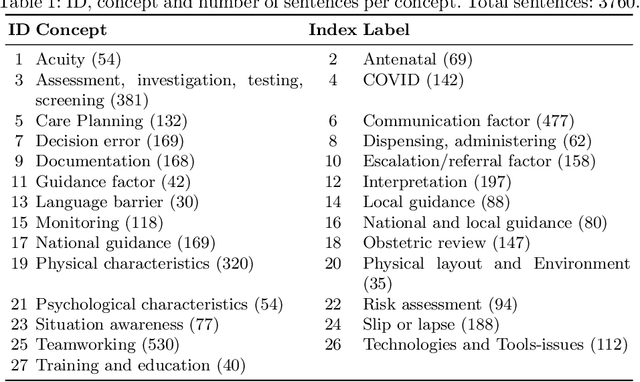
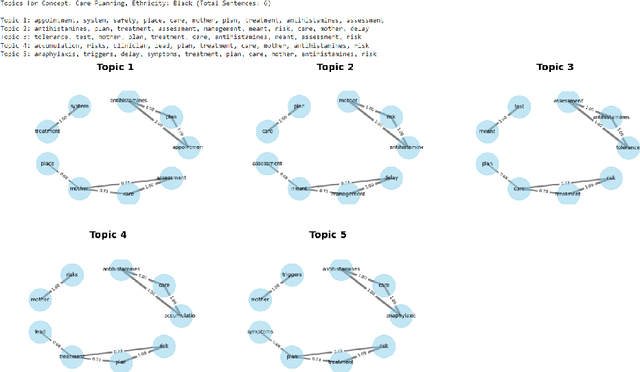

Abstract:This study applies Natural Language Processing techniques, including Latent Dirichlet Allocation, to analyse anonymised maternity incident investigation reports from the Healthcare Safety Investigation Branch. The reports underwent preprocessing, annotation using the Safety Intelligence Research taxonomy, and topic modelling to uncover prevalent topics and detect differences in maternity care across ethnic groups. A combination of offline and online methods was utilised to ensure data protection whilst enabling advanced analysis, with offline processing for sensitive data and online processing for non-sensitive data using the `Claude 3 Opus' language model. Interactive topic analysis and semantic network visualisation were employed to extract and display thematic topics and visualise semantic relationships among keywords. The analysis revealed disparities in care among different ethnic groups, with distinct focus areas for the Black, Asian, and White British ethnic groups. The study demonstrates the effectiveness of topic modelling and NLP techniques in analysing maternity incident investigation reports and highlighting disparities in care. The findings emphasise the crucial role of advanced data analysis in improving maternity care quality and equity.
Intelligent Multi-Document Summarisation for Extracting Insights on Racial Inequalities from Maternity Incident Investigation Reports
Jul 11, 2024
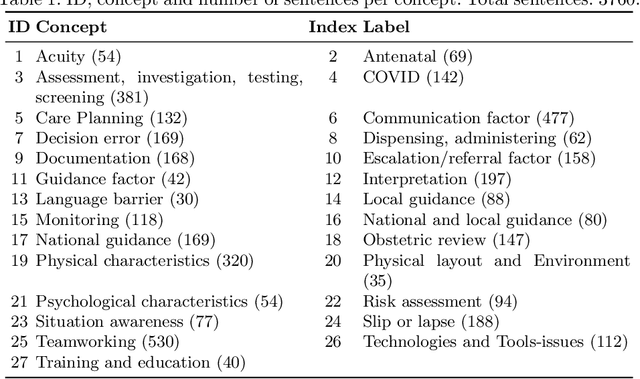
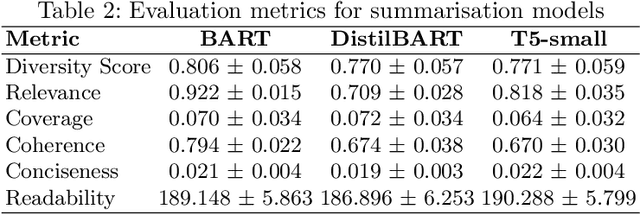
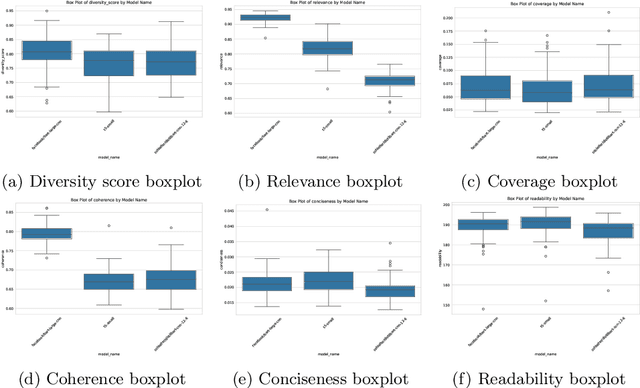
Abstract:In healthcare, thousands of safety incidents occur every year, but learning from these incidents is not effectively aggregated. Analysing incident reports using AI could uncover critical insights to prevent harm by identifying recurring patterns and contributing factors. To aggregate and extract valuable information, natural language processing (NLP) and machine learning techniques can be employed to summarise and mine unstructured data, potentially surfacing systemic issues and priority areas for improvement. This paper presents I-SIRch:CS, a framework designed to facilitate the aggregation and analysis of safety incident reports while ensuring traceability throughout the process. The framework integrates concept annotation using the Safety Intelligence Research (SIRch) taxonomy with clustering, summarisation, and analysis capabilities. Utilising a dataset of 188 anonymised maternity investigation reports annotated with 27 SIRch human factors concepts, I-SIRch:CS groups the annotated sentences into clusters using sentence embeddings and k-means clustering, maintaining traceability via file and sentence IDs. Summaries are generated for each cluster using offline state-of-the-art abstractive summarisation models (BART, DistilBART, T5), which are evaluated and compared using metrics assessing summary quality attributes. The generated summaries are linked back to the original file and sentence IDs, ensuring traceability and allowing for verification of the summarised information. Results demonstrate BART's strengths in creating informative and concise summaries.
I-SIRch: AI-Powered Concept Annotation Tool For Equitable Extraction And Analysis Of Safety Insights From Maternity Investigations
Jun 08, 2024Abstract:Maternity care is a complex system involving treatments and interactions between patients, providers, and the care environment. To improve patient safety and outcomes, understanding the human factors (e.g. individuals decisions, local facilities) influencing healthcare delivery is crucial. However, most current tools for analysing healthcare data focus only on biomedical concepts (e.g. health conditions, procedures and tests), overlooking the importance of human factors. We developed a new approach called I-SIRch, using artificial intelligence to automatically identify and label human factors concepts in maternity healthcare investigation reports describing adverse maternity incidents produced by England's Healthcare Safety Investigation Branch (HSIB). These incident investigation reports aim to identify opportunities for learning and improving maternal safety across the entire healthcare system. I-SIRch was trained using real data and tested on both real and simulated data to evaluate its performance in identifying human factors concepts. When applied to real reports, the model achieved a high level of accuracy, correctly identifying relevant concepts in 90\% of the sentences from 97 reports. Applying I-SIRch to analyse these reports revealed that certain human factors disproportionately affected mothers from different ethnic groups. Our work demonstrates the potential of using automated tools to identify human factors concepts in maternity incident investigation reports, rather than focusing solely on biomedical concepts. This approach opens up new possibilities for understanding the complex interplay between social, technical, and organisational factors influencing maternal safety and population health outcomes. By taking a more comprehensive view of maternal healthcare delivery, we can develop targeted interventions to address disparities and improve maternal outcomes.
Efficient Retrieval of Images with Irregular Patterns using Morphological Image Analysis: Applications to Industrial and Healthcare datasets
Oct 10, 2023



Abstract:Image retrieval is the process of searching and retrieving images from a database based on their visual content and features. Recently, much attention has been directed towards the retrieval of irregular patterns within industrial or medical images by extracting features from the images, such as deep features, colour-based features, shape-based features and local features. This has applications across a spectrum of industries, including fault inspection, disease diagnosis, and maintenance prediction. This paper proposes an image retrieval framework to search for images containing similar irregular patterns by extracting a set of morphological features (DefChars) from images; the datasets employed in this paper contain wind turbine blade images with defects, chest computerised tomography scans with COVID-19 infection, heatsink images with defects, and lake ice images. The proposed framework was evaluated with different feature extraction methods (DefChars, resized raw image, local binary pattern, and scale-invariant feature transforms) and distance metrics to determine the most efficient parameters in terms of retrieval performance across datasets. The retrieval results show that the proposed framework using the DefChars and the Manhattan distance metric achieves a mean average precision of 80% and a low standard deviation of 0.09 across classes of irregular patterns, outperforming alternative feature-metric combinations across all datasets. Furthermore, the low standard deviation between each class highlights DefChars' capability for a reliable image retrieval task, even in the presence of class imbalances or small-sized datasets.
Advancing continual lifelong learning in neural information retrieval: definition, dataset, framework, and empirical evaluation
Aug 16, 2023Abstract:Continual learning refers to the capability of a machine learning model to learn and adapt to new information, without compromising its performance on previously learned tasks. Although several studies have investigated continual learning methods for information retrieval tasks, a well-defined task formulation is still lacking, and it is unclear how typical learning strategies perform in this context. To address this challenge, a systematic task formulation of continual neural information retrieval is presented, along with a multiple-topic dataset that simulates continuous information retrieval. A comprehensive continual neural information retrieval framework consisting of typical retrieval models and continual learning strategies is then proposed. Empirical evaluations illustrate that the proposed framework can successfully prevent catastrophic forgetting in neural information retrieval and enhance performance on previously learned tasks. The results indicate that embedding-based retrieval models experience a decline in their continual learning performance as the topic shift distance and dataset volume of new tasks increase. In contrast, pretraining-based models do not show any such correlation. Adopting suitable learning strategies can mitigate the effects of topic shift and data augmentation.
ForestMonkey: Toolkit for Reasoning with AI-based Defect Detection and Classification Models
Jul 25, 2023



Abstract:Artificial intelligence (AI) reasoning and explainable AI (XAI) tasks have gained popularity recently, enabling users to explain the predictions or decision processes of AI models. This paper introduces Forest Monkey (FM), a toolkit designed to reason the outputs of any AI-based defect detection and/or classification model with data explainability. Implemented as a Python package, FM takes input in the form of dataset folder paths (including original images, ground truth labels, and predicted labels) and provides a set of charts and a text file to illustrate the reasoning results and suggest possible improvements. The FM toolkit consists of processes such as feature extraction from predictions to reasoning targets, feature extraction from images to defect characteristics, and a decision tree-based AI-Reasoner. Additionally, this paper investigates the time performance of the FM toolkit when applied to four AI models with different datasets. Lastly, a tutorial is provided to guide users in performing reasoning tasks using the FM toolkit.
Morphological Image Analysis and Feature Extraction for Reasoning with AI-based Defect Detection and Classification Models
Jul 24, 2023
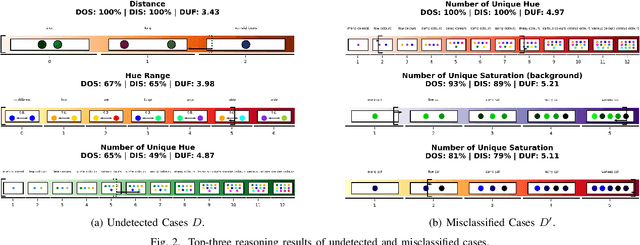


Abstract:As the use of artificial intelligent (AI) models becomes more prevalent in industries such as engineering and manufacturing, it is essential that these models provide transparent reasoning behind their predictions. This paper proposes the AI-Reasoner, which extracts the morphological characteristics of defects (DefChars) from images and utilises decision trees to reason with the DefChar values. Thereafter, the AI-Reasoner exports visualisations (i.e. charts) and textual explanations to provide insights into outputs made by masked-based defect detection and classification models. It also provides effective mitigation strategies to enhance data pre-processing and overall model performance. The AI-Reasoner was tested on explaining the outputs of an IE Mask R-CNN model using a set of 366 images containing defects. The results demonstrated its effectiveness in explaining the IE Mask R-CNN model's predictions. Overall, the proposed AI-Reasoner provides a solution for improving the performance of AI models in industrial applications that require defect analysis.
 Add to Chrome
Add to Chrome Add to Firefox
Add to Firefox Add to Edge
Add to Edge